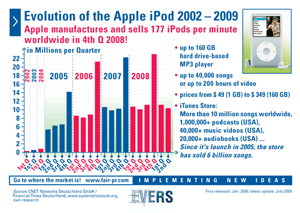Apple sold 177 iPods per minute world wide
Today I would like to familiarize you with a perhaps not so well known success story: The U.S. company Apple Inc., with headquarter in Cupertino, CA, scored a turnover of $ 8.34 billion in the 2nd Quarter 2009 and a quarterly net profit of $ 1.23 billion or $ 1.35 per share respectively. In the 1970s Apple belonged to the first manufacturers of personal computers. It also took a pioneering role in the commercial introduction of the graphical user interface and the mouse in the 1980s. With the advent of iPods and iPhones in 2001 and 2007 Apple expanded its core business.

Evolution of the Apple iPod 2002 - 2009
Thomas
Schirmaier, Arno A. Evers FAIR-PR |
Only 7 years after the introduction of its iPods, Apple produced and sold over 22 million units during the fourth quarter of 2008 (Christmas time) alone: That’s around 250 000 iPods per day, approximately 10 000 per hour or 177 devices per minute. My congratulations! The logistics behind this, in manufacturing, quality assurance, sales and cost management as well as revenue handling, is difficult to imagine, according to our H2/FC standards in which we are thinking more in generations than in shorter time spans.
The iPods of the company are a series of portable, so-called "Portable Media Player ". They are the best-selling portable music players in the world. Apple concentrated mainly on the PP3 software, as well as its further development, the AAC format. The MP3 format was developed in the 1980s by a group led by Karl Heinz Brandenburg of the Fraunhofer Institute for Integrated Circuits (IIS) in Erlangen, Germany and by the Friedrich-Alexander University Erlangen near Nuremberg in cooperation with AT & T Bell Labs and Thomson. The Fraunhofer Gesellschaft (FhG), based in Munich, Germany, owns patents on part of the software which is used in the MPEG encoding. Since September 1998 FhG / Thomson are collecting royalties for the use of the MP3 format in Electronic Music Distribution, Broadcasting and Streaming. This business added significant 83 million Euro to the income of the Fraunhofer Gesellschaft in 2008, according to the the Fraunhofer Annual Report 2008.
Additional to the sale of Apple iPod hardware, the company also developed
another brilliant business idea, which generates billions of USD of
transactions and income: With the Apple "iTunes Store" one can download or
borrow movies, TV shows, audio and games and so on. Since its founding in
2005, Apple has sold 6 billion iTunes songs, at the minimum price of 99
US-Cent/piece. Whole albums start from 9.99 Euro. The payment via credit
cards is done in fractions of a second. Apple is providing proper
invoices with VAT, all fully automatic, safe and reproducible.
History of iPods
Jon Rubinstein presented in February 2001 his first idea of an iPod to
Steve Jobs. It contained an only 1.8 inch HDD. Steve Jobs answered him:
"Go for it!" In October 2001, the first iPod with a 5 GB hard drive was
released. Meanwhile, the sixth generation with max 160 GB is on the
market. The now "iPod classic" iPod 6G was introduced by Steve Jobs at a
special event with the name "The Beat Goes On" in San Francisco in
September 2007. The product range now includes the following variants:
iPod mini, iPod nano, iPod shuffle, iPod touch, iPod photo and iPod
"Special Editions".
Wide range of accessories available
The iPod is by default only delivered with minimal equipment. This has
implemented the development of its own industry of accessories
manufacturers for the iPod worldwide. The
products offered range from standard accessories such as protection cover
to FM transmitters.
Several vendors supply systems to integrate the iPod in hi-fi equipment or
"Base stations" with speakers, developed to listen to the iPod without
using headphones.
Rechargeable batteries based on lithium -
The iPod batteries are usually loaded via a USB cable directly from the
laptop or computer. The maximum battery life, according to official Apple
figures is currently up to 36 hours at 128 Kbps. When designing all iPod
models, a change in the internal batteries from the user is not supported
or intended. Depending on the design (iPod, iPod mini) batteries are
available from third-party manufacturers. Out of warranty service Apple
offers an exchange of batteries; however, this is significantly more
expensive than the installation by the user.
For the battery charge far away from a computer Apple and third-party
manufacturers are also offering accessory chargers. However, all these are
only charging from the grid, ie 110 to 240 VAC will be transformed down to
the required charging tension and then rectified to DC. The resulting
conversion losses (heat) are currently not mentioned at all - they are
also not included in any statistics.
Why no fuel cell systems inside?
Unfortunately, there is still no iPod with an integrated fuel cell
systems, with hydrogen or another hydrogenous medium as energy carrier.
But there must be one or even several reasons for this? With so much
concentrated creativity, customer focus, marketing strength and market
orientation as with the success story of the Apple iPod it should be
possible, to employ fuel cells instead of conventional batteries. The
global fuel cell community in this context speaks of "portable
niche applications "or" special markets ". I see, however, huge niches.
And even greater markets. Who will fill them?
Links to the News:
Date: 11.08.2009 |
